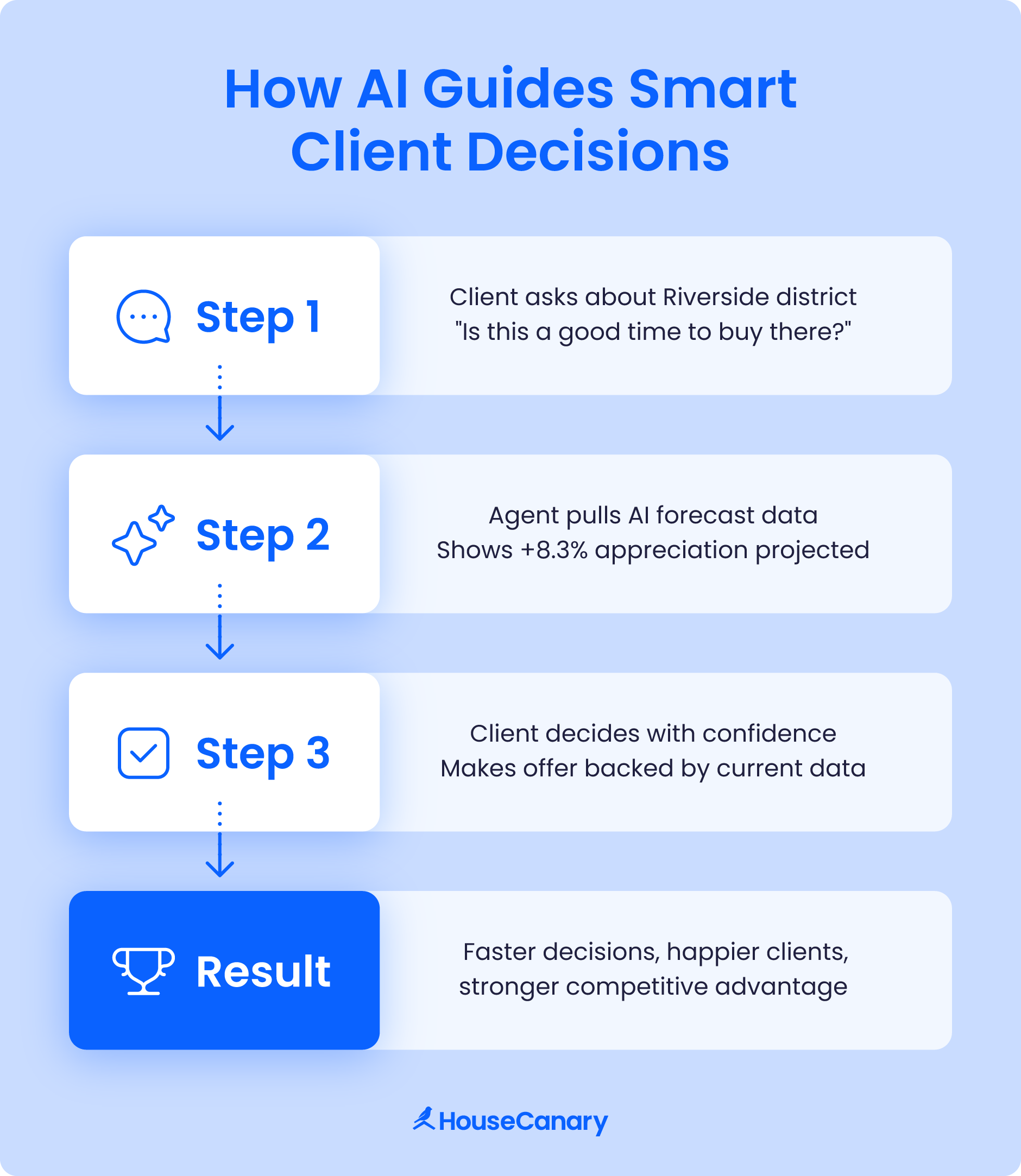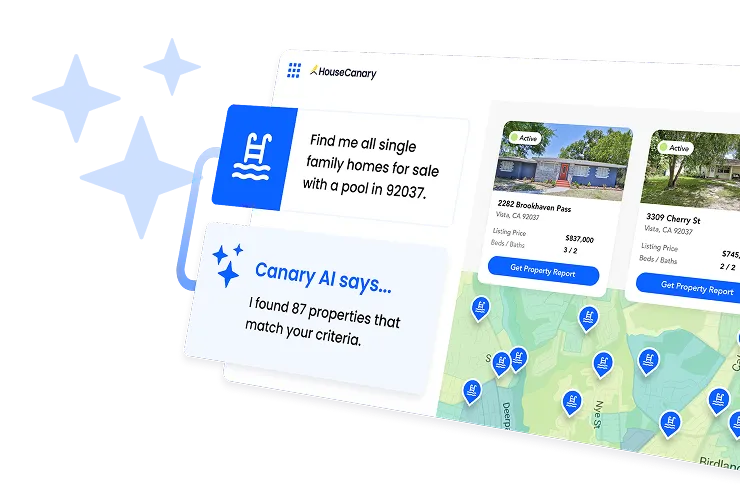
Wouldn’t it be nice to have a map directing you to the most promising real estate endeavors? With AI, this dream is a little less far-fetched. AI tools not only help realtors pinpoint top properties, but also help guide housing market forecasts.
HouseCanary’s predictive model analyzes millions of data points to set you in the right direction. It zooms in beyond statewide averages to reveal zipcode-level insights and give investors and agents a sharper projection.
Let’s cover how AI impacts the industry, the top five neighborhoods set for price jumps, and how you can use real estate forecasts to your advantage.
Key Takeaways
- Double-digit price growth markets emerge: AI forecasting flags Stevens Point–Plover, WI, and Springfield, OH, as the nation’s top price appreciation hotspots, each projected to jump +10.9% over the next 12 months.
- Unexpected metros lead 2026 price acceleration: Mid-sized and often overlooked regions—like Rochester, NY, and Rockford, IL—are projected to see 10.5% price growth, outpacing many major cities.
- AI reveals rising demand in smaller coastal markets: Erie, PA, stands out with a forecasted +10.1% increase in price, highlighting renewed interest in affordable waterfront metros.
How AI Impacts the Real Estate Industry
Think of AI as your co-pilot. You’re still in the driver’s seat, but AI helps you make that next left turn. An AI-driven real estate forecast goes beyond traditional projections by not only analyzing statewide or citywide trends, but also identifying micro-level opportunities at the neighborhood or zipcode level.
General industry benefits include:
- Automated operations: Streamline office tasks like lead qualification, tenant screening, and paperwork, freeing professionals to focus on clients.
- Better property management: Optimize rental income and reduce maintenance costs using intelligent platforms.
- Upgraded marketing and virtual staging: Increase property inquiries and lead generation with AI-powered tools.
AI can help professionals work more efficiently and make sense of complex market data. Let’s look at how CanaryAI provides more detailed insights.
Where CanaryAI Gives You an Edge in the Market
Tools like CanaryAI bridge the gap between macro forecasts and these emerging opportunities, helping you spot high-potential areas before the broader market catches on.
Canary-AI-specific benefits include:
- Image-based valuations: Analyze client-uploaded photos to adjust for property condition, delivering more accurate AVM estimates without extra data entry.
- Market grades at the zipcode level: Quickly assess which neighborhoods are trending up or down.
- Context-aware answers: Enhanced AI reasoning provides more thorough and relevant responses, accelerating research.

5 Neighborhoods Expecting High Price Growth
HouseCanary’s proprietary 12-month forward ZIP code–level Home Price Index (HPI) real estate market forecast reveals the U.S. neighborhoods poised for the steepest home price gains through 2026.
These forecasts use millions of property records, transaction histories, and local market indicators to help pinpoint where prices are rising fastest. They reveal emerging real estate market trends before they reach the general market.
Stevens Point–Plover, WI
Forecasted growth: +10.9%
Zip code: 54481
This mid-sized Wisconsin hub leads the nation in forecasted appreciation. Affordable inventory, strong employment from local universities and healthcare systems, and low construction activity have created a supply squeeze that’s driving prices upward.
The region’s small-city stability continues to attract both first-time buyers and investors priced out of Madison or Milwaukee.
Springfield, Ohio
Forecasted growth: +10.9%
Zip code: 45344
Springfield’s housing momentum reflects the broader resurgence of western Ohio. Industrial expansion and logistics investment are reshaping the area’s economy, while the nearby Wright-Patterson Air Force Base provides employment opportunities and supports local businesses.
Limited listings and migration from Dayton and Columbus suburbs are further amplifying price pressure.
Rochester, NY
Forecasted growth: +10.5%
Zip code: 14624
Rochester’s west-side neighborhoods are set for notable home price gains over the next year. The area is becoming a hotspot for growth through 2026, attracting buyers with a mix of affordable housing and strong local employment in healthcare and tech.
This steady demand from both first-time buyers and investors is creating sustained upward pressure on prices in ZIPs like 14624..
Rockford, IL
Forecasted growth: +10.5%
Zip code: 61109
Rockford’s affordability advantage is attracting new residents and investors from the Chicago metro area. Combined with limited new construction and manufacturing job gains, that imbalance is expected to push prices up more than 10% over the next year. Rental demand is also rising sharply, reinforcing long-term growth potential.
Erie, PA
Forecasted growth: +10.1%
Zip code: 16507
Erie’s housing recovery is accelerating, anchored by ongoing waterfront redevelopment and improved job prospects. As one of Pennsylvania’s most affordable metros, it is projected to see double-digit growth. This highlights the potential of smaller, overlooked markets attracting both remote workers and regional investors.

What the Top Neighborhood Trends Reveal
Across the five neighborhoods highlighted, several common patterns stood out:
- Affordability attracts buyers and investors: Mid-sized, cost-effective metros are experiencing accelerated demand.
- Employment hubs drive growth: Areas with stable jobs in healthcare, education, logistics, or manufacturing see faster appreciation.
- Limited new construction intensifies price pressure: Supply constraints paired with steady demand amplify projected gains.
“HouseCanary’s AI doesn’t just show where the market is—it reveals where it’s going. By pinpointing neighborhood-level opportunities before they hit the mainstream, we empower real estate professionals to make bolder investment decisions.”
—Chris Stroud, HouseCanary Chief Research Officer and Co-Founder
HouseCanary tools like Property Explorer allow you to monitor these trends in real time, adjust strategies, and find ideal listings before they hit mainstream awareness.
Implications for Real Estate Professionals
We’ve covered how AI impacts the real estate industry as a whole, but how does it directly apply/ Here’s how different real estate professionals can put AI to work in realistic settings.
For Investors
- Target top neighborhoods early: Use predicted growth trends to prioritize acquisitions where ROI potential is highest.
- Refine renovation strategies: Align rehab investments with projected value increases to maximize profit margins using AI tools.
- Plan exit timelines: Forecast neighborhood appreciation to decide the optimal hold period for each property.
For Lenders
- Mitigate collateral risk: Focus lending on ZIP codes forecasted for steady appreciation, reducing exposure.
- Improve underwriting precision: Incorporate AI-driven projections into loan assessments for more accurate risk modeling.
- Accelerate decision-making: Quickly flag properties that meet risk-return criteria, streamlining approvals.
For Agents and Brokers
- Provide AI-backed guidance: Recommend pricing strategies grounded in predictive analytics rather than historical trends alone.
- Differentiate client service: Use hyper-local insights to identify neighborhoods likely to appreciate, giving clients the upper hand.
- Simplify client education: Present complex forecasts in clear, actionable terms that help clients make confident decisions.

The Future of AI in Real Estate Forecasting
As AI becomes more common in real estate forecasting, regulatory guidance and transparency are increasingly important. Oversight helps ensure AI predictions are accurate, unbiased, and interpretable, giving professionals confidence in the data they use.
At the same time, the industry is standardizing key metrics, like HPI at the ZIP code level, making insights more consistent across markets.
These developments allow AI to be integrated more effectively into strategic workflows. Investment firms, lenders, and advisory practices are using AI not just for analysis, but to support decisions on pricing, risk, and market entry.
By combining standardized metrics with oversight, AI helps professionals turn complex data into actionable insights while maintaining reliability.
Addressing Challenges AI Faces
While there are many benefits of AI in real estate, it’s important to remain aware of the good, the bad, and the ugly of AI. Some challenges include:
- Data privacy and compliance
- Maintaining forecast accuracy in volatile markets
- Avoiding algorithmic bias in property valuation
- Integration with legacy systems in real estate offices
HouseCanary stays ahead by combining high-quality, multi-source data and ongoing model validation to deliver trustworthy forecasts.
“Real estate has always been about location — now it’s also about prediction. CanaryAI shows where opportunity is forming, giving our users an edge long before the market catches up.”
—Jeremy Sicklick, HouseCanary CEO and Co-Founder
Turn AI Insight into Better Real Estate Decisions with HouseCanary
HouseCanary transforms complex housing data into real-time insights, helping you confidently forecast trends and evaluate properties. Recent upgrades to Market Insights help you understand local market drivers faster through AI-generated summaries and broader ZIP code coverage.
The Portfolio Monitor also now includes Propensity to Refinance triggers, alerting users to potential changes in property activity. Meanwhile, ComeHome offers smarter, configurable CTAs to engage clients with personalized, actionable insights.
Explore HouseCanary’s platform today and turn data into smarter decisions, faster sales, and stronger client outcomes.
Methodology
HouseCanary’s AI-driven Home Price Index (HPI) forecast is built from millions of verified property records, transaction histories, and market indicators across the U.S. The model evaluates trends in pricing, supply, demand, and local fluctuations to predict home value movements at the ZIP code level over a 12-month horizon.
























